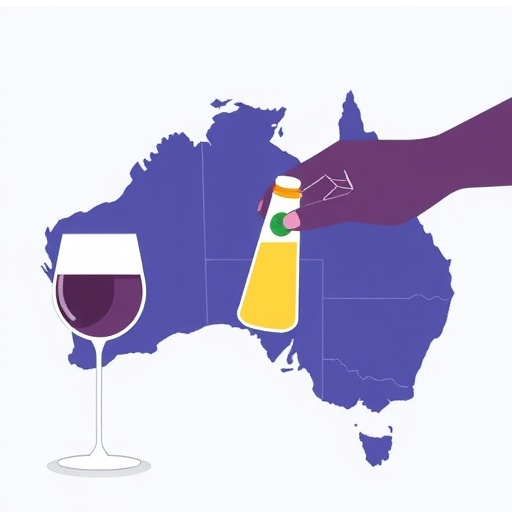Alcohol consumption remains a critical public health challenge worldwide, with its multifaceted impact on morbidity, mortality, and socioeconomic burden. In Australia, recent epidemiological modeling developed by Griffith University researchers has projected a staggering financial and health toll attributed to alcohol-related diseases and injuries. Their newly developed tool, The Alcohol Policy (TAP) model, offers an unprecedented quantification of avoidable disease incidences, injury cases, and healthcare expenditures tied to alcohol use in the Australian population aged over 15 years.
The TAP model is a multistate life table simulation that intricately links alcohol consumption patterns with population-level health outcomes over time. By integrating epidemiological data, behavioral risk factors, and healthcare cost parameters, the model enables precise forecasting of potential health benefits and cost savings achievable through alcohol consumption reduction policies. This sophisticated approach marks a significant advancement in public health policy planning by allowing evaluation of long-term outcomes beyond cross-sectional or cohort observational data.
Dr. Mary Wanjau, leading the study within Griffith’s School of Medicine and Dentistry, highlighted alarming projections if current alcohol consumption trends persist unchecked. The data reveal that completely eliminating alcohol use over the initial 25 years could prevent over 25 million cases of disease and injury, reducing alcohol-attributable deaths by more than 200,000. Notably, a majority of these preventable deaths would result from alcohol-related cancers, a category historically recognized for its dose-dependent risk escalation with alcohol intake.
The economic implications are equally profound. The model estimates that if Australian society transitioned to zero alcohol consumption swiftly, the healthcare system could avert approximately $55 billion in expenditures within the first 25 years alone. Extending the horizon, the total projected burden related to alcohol’s health effects reaches $68 billion over six decades, validating the urgency for proactive interventions. These findings equip policymakers with robust quantitative evidence to prioritize alcohol harm reduction as a strategic public health investment.
Beyond economics, the study corroborates global observations about the absence of a safe threshold for alcohol consumption concerning overall health. Epidemiological evidence demonstrates a monotonic increase in cancer risk and all-cause mortality proportional to alcohol intake levels. Such dose-response relationships underscore the inadequacy of moderate drinking recommendations and argue for population-level strategies aimed at minimizing consumption prevalence.
Particularly vulnerable are young adults aged 15 to 39 years, who disproportionately bear the acute consequences of excessive alcohol use. Injury-related mortality and disability rates peak in this age group due to alcohol’s role in accidents, violence, and other trauma. The TAP model quantifies how targeted reductions among younger cohorts could substantially alleviate the societal burden of acute sequelae of alcohol, enhancing both public safety and individual health trajectories.
Importantly, the model also illustrates that even minor decreases in average alcohol consumption across the entire population can yield significant public health gains. These benefits extend beyond clinical outcomes into substantial reductions in healthcare resource utilization and associated costs. Such gradations in consumption also ameliorate the social and economic impacts felt by affected individuals, families, communities, and governmental systems.
Professor Lennert Veerman, co-author of the study, emphasized the critical role of policy in shaping consumption environments conducive to harm reduction. Evidence supports approaches that increase abstinence rates, delay initiation of drinking age, and lower average per capita alcohol intake. Population-level policies—including taxation, marketing restrictions, and availability controls—create systemic conditions aligning with these objectives and have demonstrated efficacy in reducing alcohol-related health burdens.
The research findings delineate a clear and substantial cost of inaction in addressing alcohol-related harms. In the context of Australia, where alcohol remains the most prevalently used psychoactive substance, these insights underscore the indispensability of strengthened alcohol control frameworks. Without decisive intervention, the dual epidemics of alcohol-attributable chronic disease and injury will continue to exact rising tolls on public health and fiscal sustainability.
This landmark study is documented in the peer-reviewed International Journal of Mental Health and Addiction, where the article titled “The Avoidable Health Burden and Healthcare Costs Related to Alcohol Consumption in Australia: Multistate Life Table Modelling” presents the detailed methodology and comprehensive results. Its publication offers a timely and rigorous foundation for evidence-based health policy reform aimed at curbing alcohol-related damage.
Ultimately, the TAP model’s integration of epidemiological data with health economic forecasting provides a valuable blueprint for governments, health agencies, and stakeholders seeking to mitigate alcohol harms. It crystallizes the formidable health and economic dividends achievable through targeted, sustained reductions in alcohol consumption at a population scale. The study affirms that alcohol harm is not an inevitable societal cost, but a preventable burden requiring urgent and sustained policy commitment.
Subject of Research: People
Article Title: The Avoidable Health Burden and Healthcare Costs Related to Alcohol Consumption in Australia: Multistate Life Table Modelling
News Publication Date: 14-Nov-2025
Web References: http://dx.doi.org/10.1007/s11469-025-01545-8
Keywords: Health care, Alcohol-related diseases, Public health policy, Epidemiological modeling, Healthcare costs, Alcohol consumption, Cancer risk, Injury prevention, Population health




